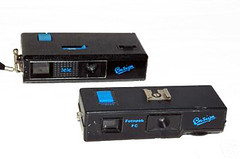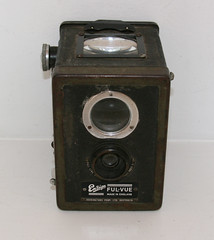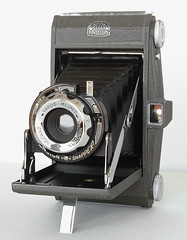Houghton and Ensign

|
| 1913 advertisement by G. Gennert scanned by Uwe Kulick (Image rights) |
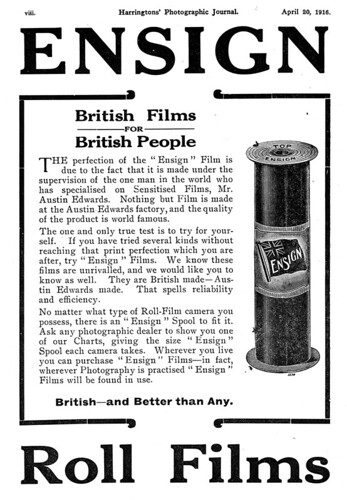
|
| 1916 advertisement with a reference to Mr. Austin Edwards scanned by Geoff Harrisson (Image rights) |
The company Houghton or Houghtons, and its successors Houghton-Butcher, Barnet Ensign, Barnet Ensign Ross and Ross-Ensign, was one of Britain's most successful camera-makers.
Contents
History
In 1834 George Houghton joined the Frenchman[1] Antoine Claudet to manage a glass warehouse in London, under the name Claudet & Houghton.[2] It became George Houghton & Son in 1867, then George Houghton & Sons in 1892.[3]
The company's headquarters at 88/89 High Holborn were called Ensign House in 1901,[4] and the production of the roll film brand Ensign began in 1903. The first Ensign logo was a shop sign with the letter "N" inside, and was replaced in 1911 by the name ENSIGN written inside the British marine flag.[5]
In 1903, the company was incorporated as George Houghton & Sons Ltd.,[6] and in March 1904 it absorbed Holmes Bros. (the maker of the Sanderson cameras), A. C. Jackson, Spratt Bros. and Joseph Levi & Co., to form Houghtons Ltd.[7] The Alliance Roll-film Camera Co. Ltd which Houghtons had an interest in was wound up in 1904, their cameras carried the Ensign name. The new company carried on the production of the smaller companies it had absorbed, and notably continued production of the Sanderson cameras until 1939.
In the early 1900s the company built a factory for the production of cameras on the Fulbourn Road in Walthamstow.[8] In 1908 this was the biggest British camera factory.[9]
Houghton was a renowned maker of magazine cameras like the Klito. Another characteristic product of Houghton was the Ensignette, a folding camera developed by the Swedish engineer Magnus Neill.
In 1915, Houghtons Ltd. came into a partnership with W. Butcher & Sons Ltd, founding the joint venture Houghton-Butcher Manufacturing Co., Ltd. to share the manufacturing facilities.[10] (This agreement was essential for Butcher, which had no manufacturing plant and was mainly trading imported German cameras before the outbreak of World War I.) The two companies Houghtons and Butcher continued to trade separately, and the camera designs remained distinct.[11]
The two trading companies finally merged on January 1st, 1926 to form Houghton-Butcher (Great-Britain) Ltd., which was renamed Ensign Ltd. in 1930.[12] (The manufacturing company based at Walthamstow kept the name Houghton-Butcher Manufacturing Co., Ltd. until 1945.)[13] The new trading company kept many of Houghtons and Butcher's camera ranges. In 1939 it introduced the Ensign Ful-Vue box camera, one of the most popular cameras of its time in the UK.
The headquarters of the trading company Ensign Ltd. were destroyed by an air raid on the night of September 24–5, 1940.[14] The assets of this company were taken over by Johnson & Sons, but the trademark Ensign was kept by the manufacturing company Houghton-Butcher Manufacturing Co., Ltd., which assumed the advertising and distribution of the Ensign cameras alone until 1945.[15]
In 1945, Houghton-Butcher Manufacturing Co., Ltd. associated with the film maker Elliott & Sons Ltd. (maker of the film brand "Barnet") and became Barnet Ensign Ltd.[16] In 1948 Ross and Barnet Ensign were merged to Barnet Ensign Ross Ltd., which was finally renamed Ross-Ensign Ltd. in 1954.[17]
After World War II, the company soon abandoned the sophisticated Ensign Commando rangefinder camera and continued the range of Ensign Selfix and Ensign Autorange folding cameras, while introducing new models like the Ensign Ranger or the Snapper. Among simpler cameras, a new version of the Ensign Ful-Vue was released in 1946, which was further developed to the Ful-Vue Super and Fulvueflex pseudo-TLR.
The company stopped making cameras in 1961.[18]
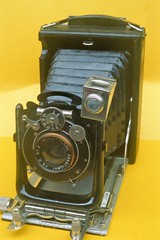
|
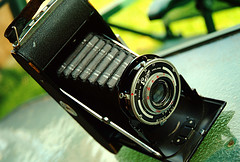
|

|
| Ensign folding plate camera Image by Uwe Kulick (Image rights) |
Ensign Trikon Ranger, Ensar Anastigmat 105mm f/6.3 lens Image by eastendimages (Image rights) |
Ensign Greyhound Image by Paola Marinangeli (Image rights) |
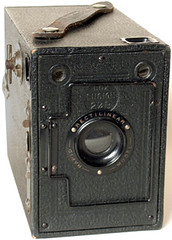
|
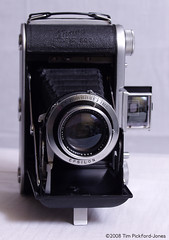
|

|
| Box Ensign 2¼B Image by AWCam (Image rights) |
Ensign Selfix 820 Image by Tim Jones (Image rights) |
Ensignette No. 1 Image by Gerry Wiseman (Image rights) |
Houghtons cameras (some carried the Ensign logo)
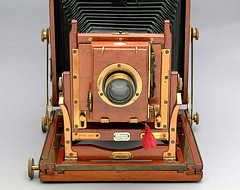
|
| 1/2 plate Triple Victo image by Geoff Harrisson (Image rights) |
- Briton no.s 1, 1a, 2 & 3
- Duchess
- Empress
- King
- May Fair (box)
- Mascot
- Queen
- Royal Mail Stereolette
- Shuttle
- Smyth Stereo- Handkamera
- Stereo Victo
- Sylvar
- Ticka watch camera
- Triple Victo
- Triple Victo Stereo
- Tropical Victo
- Tudor
- Verifying Camera
- Victo
- Victo Superbe
Cameras using the Ensign brand name
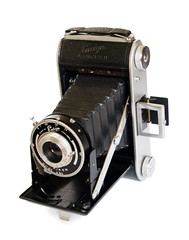
|
| Ranger II image by Tim Williams (Image rights) |
- Alliance Roll-film Camera Co. Ltd, Ensign England,(110 Roll film camera)
- All-Distance Ensign (large range of box & folders)
- All-Distance Pocket Ensign (folder)
- Duo-Ensign 2¼B (box, about 1930)
- Ensign 16-20 (4.5x6cm folder)
- Ensign 12-20 (folder)
- Ensign 2¼ A box ("Ton Box")
- Box Ensign 2¼ B
- Ensign 2¼ B (folding)
- Ensign 2½ Box
- Ensign All-Distance Twenty (box)
- Ensign All-Distance Pocket (folder)
- Ensign Autorange
- Ensign Autorange 16-20 (rangefinder folder)
- Ensign Autorange 220 (rangefinder folder)
- Ensign Autorange 820 (rangefinder folder)
- Ensign Autospeed
- Ensign Box Duo
- Ensign Caddy
- Ensign Cadet
- Ensign Cameo / Super-Speed Cameo / Cameo Luxus (folding, plate)
- Ensign Carbine (large range of folders)
- Ensign Clubman (folding)
- Ensign Commando (coupled-rangefinder folder for 6x6 and 4.5x6)
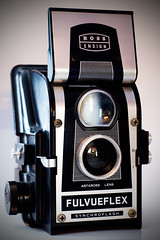
|
| Fulvueflex image by Danny Austin (Image rights) |
- Ensign Cupid (small viewfinder camera)
- Ensign Deluxe Reflex (large plate SLR)
- Ensign Double-8 (folding, 3x4 on 127)
- Ensign E20 (box)
- Ensign E29 (box)
- Ensign Focal Plane Roll Film Reflex (120 film SLR)
- Ensign Folding Reflex (SLR)
- Ensign Ful-Vue (pseudo-TLR)
- Ensign Greyhound (folder)
- Ensign Junior (box)
- Ensign Klito Nos. 0 and 00 (folding, plate)
- Ensign Klito No.1 (falling plate box)
- Ensign Klito No.4 (falling plate box)
- Ensign Klito de Luxe No.9 (folding, plate)
- Ensign Klito Junior (folding, plate)
- Ensign Midget (strut folder)
- Ensign Multex (range of rangefinder 127 roll-film cameras, vaguely Leica-inspired)
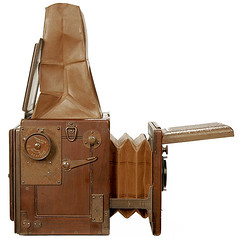
|
| Ensign Special Reflex, Tropical image by Rick Soloway (Image rights) |
- Ensign No. 3 and No. 3A; large folders similar to the Carbine range
- Ensign No.12 Watch Pocket Carbine
- Ensign Perfect Reflex
- Ensign Pocket (large range of folders, e.g. Pocket 20, Pocket E-20)
- Ensign Popular Press-Camera
- Ensign Post Card
- Ensign Popular Reflex (large plate SLR)
- Ensign Ranger (range of folders)
- Ensign Reflex (large plate SLR)
- Ensign Roll Film Reflex (simple 120 film SLR with T&I shutter)
- Ensign Simplex pocket model
- Ensign Selfix (large range of folders)
- Ensign Singlo (folder)
- Ensign Speed Film Reflex (120 6x9 SLR)
- Ensign Special Reflex (large plate SLR)
- Ensign Sprite
- Ensign Watch Pocket Carbine (folder)
- Ensignette (strut folder)

|
| No.1 Aluminium Ensignette image by Geoff Harrisson (Image rights) |
- Ensign Reflex Tropical (large plate SLR)
- J-B Ensign (cheap box)
- Ross-Ensign Ful-vue Super (pseudo-TLR)
- Ross-Ensign Fulvueflex (pseudo-TLR)
- Ross-Ensign Snapper - see Ensign Selfix Snapper (folder)

|
| Advertisement for Ensign cine cameras in Asahi Camera June 1932. (Image rights) |
There was also a range of Ensign cine cameras.
- Ensign Auto Kinecam 16 / 16B
- Ensign Cinematograph
- Ensign Cinematograph Tropical
- Ensign Kinecam 4 / 6
- Ensign Super Kinecam
The Ensign name was revived in the 1980s for some 110 cameras.
|
|
Notes

|
| Ensign Ful-Vue image by snapper31 (Image rights) |
- ↑ Ensign history page at ensignphotographic.com.
- ↑ Channing and Dunn, p.54, McKeown, p.393.
- ↑ McKeown, p.393.
- ↑ "Ensign House": Channing and Dunn, p.54.
- ↑ Ensign history page at ensignphotographic.com.
- ↑ Channing and Dunn, p.54, saying "George Houghton & Son Ltd."
- ↑ Channing and Dunn, pp.54–5.
- ↑ Early 1900s: Channing and Dunn, p.55; Fulbourn Road: Ensign history page at ensignphotographic.com.
- ↑ Ensign history page at ensignphotographic.com.
- ↑ Channing and Dunn, pp.29 and 54, McKeown, pp.171 and 393.
- ↑ Channing and Dunn, pp.29 and 54, McKeown, pp.171 and 393.
- ↑ Channing and Dunn, p.55, McKeown, p.393.
- ↑ Channing and Dunn, p.55.
- ↑ McKeown, p.393.
- ↑ Channing and Dunn, pp.21 and 55, McKeown, p.393.
- ↑ Associated with Elliott and Sons Ltd. and became Barnet Ensign Ltd. in 1945: Channing and Dunn, p.21, McKeown, p.393. Elliott & Sons maker of the Barnet film brand: Ensign history page at ensignphotographic.com.
- ↑ Channing and Dunn, p.21, McKeown, p.393.
- ↑ Channing and Dunn, p.21, McKeown, p.393.
Bibliography
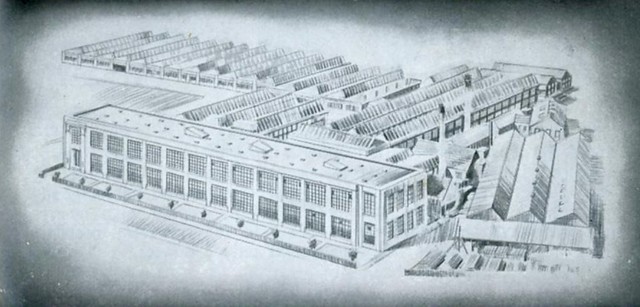
|
| Image from catalog 1937: The ENSIGN WORKS at Walthamstow: The Largest Camera Factory in the BRITISH EMPIRE. scanned by Nesster (Image rights) |
- Asahi Camera. Advertisement by Photo News Sha and Fukada Shōkai in June 1932 (p.A8).
- Channing, Norman and Dunn, Mike. British Camera Makers. An A-Z Guide to Companies and Products. London : Parkland Designs, 1996. ISBN 0-9524630-0-8 Pp.21–2 and 54–8.
- McKeown, James M. and Joan C. McKeown's Price Guide to Antique and Classic Cameras, 12th Edition, 2005-2006. USA, Centennial Photo Service, 2004. ISBN 0-931838-40-1 (hardcover). ISBN 0-931838-41-X (softcover). Pp.393–409.
Links
| British companies | ||
| Adams & Co. | Agilux | Aldis | APeM | Aptus | Artima | Barnet Ensign | Beard | Beck | Benetfink | Billcliff | Boots | British Ferrotype | Butcher | Chapman | Cooke | Corfield | Coronet | Dallmeyer | Dekko | De Vere | Dixons | Dollond | Elliott | Gandolfi | Gnome | Griffiths | G. Hare | Houghtons | Houghton-Butcher | Hunter | Ilford | Jackson | Johnson | Kentmere | Kershaw-Soho | Kodak Ltd. | Lancaster | Lejeune and Perken | Lizars | London & Paris Optic & Clock Company | Marion | Marlow | Meagher | MPP | Neville | Newman & Guardia | Pearson and Denham | Perken, Son and Company | Perken, Son & Rayment | Photopia | Purma | Reid & Sigrist | Reynolds and Branson | Ross | Ross Ensign | Sanderson | Sands & Hunter | Shackman | Shew | Soho | Standard Cameras Ltd | Taylor-Hobson | Thornton-Pickard | Underwood | United | Watkins | Watson | Wynne's Infallible | Wray |
In English:
- Ensign Camera website, including:
- Ensign history and folding cameras at ozcamera
- Ensign Handbook of Photography and 1912 list of models at Mike Butkus' www.butkus.org
- Houghton camera listing with reference information at Historic Camera
- Ensign E29 camera at The Old Album
- PDF of 30 Ensign PDF manuals from OrphanCameras.com website (alphabetical arrangement)
- Ensign catalogues for 1912, 1930 and 1935 at Pacific Rim
In French:
